Provide exercise, activities, and challenging mental stimulation
By Michele Welton, Dog Trainer, Breed Selection Consultant, Author of 15 Dog Books
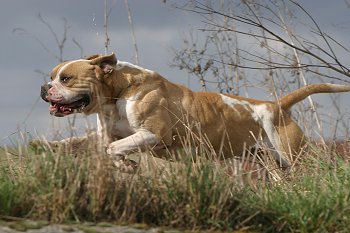
American Bulldog on the run!
Exercise is absolutely vital for dogs. Dogs who don't get enough exercise are unfit and live shorter, unhealthier lives.
Exercise keeps your dog's heart, lungs, muscles, and joints strong and healthy, so that he lives longer and more comfortably.
How much exercise your dog needs
- As much as it takes to keep his body trim. As we discussed in this feeding chapter, your dog should be on the slim side. He should have a discernible "waist" and a taut underbelly, and you should be able to feel his ribs with your fingers.
- As much as it takes to satisfy him and prevent the hyperactivity and destructive behaviors (such as chewing and barking) that occur when a dog has excess energy with no other means to vent it.
Your dog's MIND needs to be exercised, too.
Mental stimulation is as important for dogs as it is for people. When we have nothing to think about, nothing new to look forward to, no hobbies or intellectual pursuits, we're bored. As the saying goes, "Use it or lose it!"
Dogs are even vulnerable to a form of dementia called Canine Cognitive Dysfunction, which is similar to Alzheimer's disease. Help keep your dog's mind healthy by providing interesting activities that encourage him to be attentive, to think, to reason, to figure things out.
Such activities are also a terrific way to strengthen your relationship with your dog – a win-win situation!
The myth of "exercising" in the back yard
Some owners think their dog gets all the exercise he needs just by "running around" the yard.
A few dogs will indeed run around in a large yard. But most dogs just wander around in a leisurely manner, sniffing, peeing, sniffing, pooping, sniffing... then they sprawl in the sun (or shade) and snooze. Needless to say, this provides zero exercise.
Of course, some dogs do "exercise" in the yard – they're bored stiff, so they run up and down the fence line barking at passersby or UPS trucks or the neighbor's dog or the neighbors. I recommend calling the police or your homeowners' association on these inconsiderate owners.
Also don't make the mistake of thinking that just because you have two dogs, it's a done deal that they will help keep each other exercised.
Many dogs who live together do just that – they live together. They may follow each other around, but if they're not actively running and playing, they're not keeping each other exercised.
Now if YOU go outside and walk (or run) around the yard with your dog, he will get much more exercise, especially if you play Fetch or Tug games. Go ahead: it's fun!
Master list of exercise options
Walking on leash
Walk different routes, especially routes where something interesting is happening (say, a ball game at the park). This will encourage your dog to lift his head and pay attention. If your dog doesn't walk nicely on a leash, see my free online training program.
Free running
This option is only safe if the area is enclosed, or if your dog always comes when called. The problem is that if he gets too far away or if there's wind or noise, he can't hear you call.
A modern remote collar (like the Mini Educator ET-300) can solve this problem.
No, you don't "shock" your dog! You set the level on such a low tingle/vibration that the dog can barely feel it. You don't use it to punish him. Just the opposite! You teach him that when he feels that tingle/vibration, it's the same as a Come command, and when he comes to you, he'll get a reward. Yay!
This modern use of a remote collar gives your dog freedom to run clear across a field because you can always reach out beyond your voice range and "tap him on the shoulder" to call him.
 Fetch games
Fetch games
With balls, sticks, toys, or flying disks.
Tug games
Controlled Tug of War is a great game to play with most dogs.
Playing with other dogs
Your own dog, or a friend's dog who you know well. I don't allow my dogs to play with dogs I don't know well. Too much risk.
Dog parks
A dog park is a fenced area especially designed for dogs to gather and play off-leash with other dogs. Dog parks have sprung up in many cities and neighborhood developments.
I don't recommend dog parks. In my opinion, letting your dog play with other dogs that you can't control is so risky. It can take only one instance in which your dog is attacked for him to start acting aggressively toward other dogs for the rest of his life. His mentality becomes, "I'll get them before they get me."
Owners consult with me all the time about these psychologically scarred dogs. "It was just that one time," they say mournfully.
Most owners stand around a dog park chatting, laughing, and talking on their phones while their dog's body language (or some other dog's body language) is flashing bright red warning signs that a fight might be imminent. Most dog owners haven't a clue about dog behavior when they're in a group/pack situation.
I don't put my dogs' lives in the hands of other owners.
Your dog doesn't need to play with other dogs in order to have a long and happy life. He really, really doesn't.
It's especially dangerous to take a small dog to a dog park. Larger dogs often view smaller dogs as prey. A sudden movement, such as your small dog pouncing on a leaf, can trigger dormant chasing instincts even in a nice dog who means well. He can seize your little one instinctively, before he even thinks about what he is doing, before you have time to move or draw a breath. No, I really don't recommend dog parks.
"Pulling" activities
An athletic dog can pull you on a sled (sledding), on a 2-wheeled scooter (scootering), on a 2- or 4-wheeled cart (carting), or on cross-country skis (skijoring). Or your dog can pull a sledge loaded with weights (weight-pulling).
Obstacle course (agility)
Over the hurdles... up the ramp... across the plank... down the ramp... through the tunnel... is this a playground? Yes, a playground for dogs!
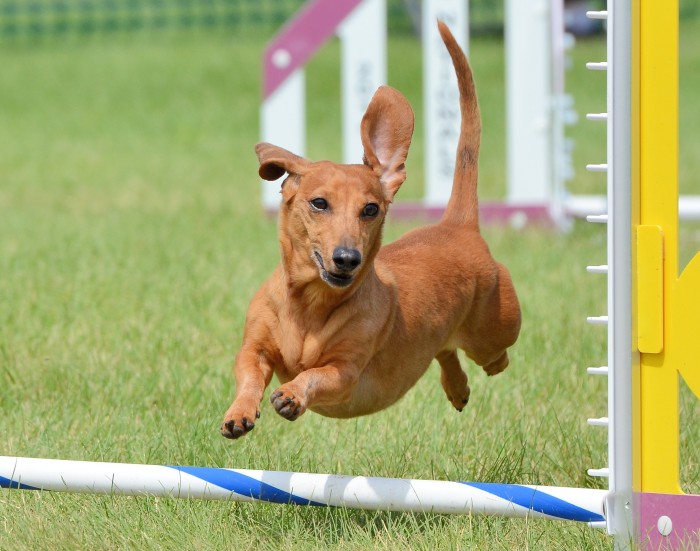
Agility is an obstacle course sport for dogs. Agility teaches your dog to pay attention to you, follow your directions, remember the names of the different obstacles, and remember how to negotiate each obstacle. Agility builds your dog's self-confidence, which is especially valuable for a young or timid dog.
To find (or make) obstacles, and to teach your dog to traverse them, see my free online training program, Teach Your Dog 100 English Words.
Swimming
Swimming is one of the best physical activities for dogs.
 The buoyancy of water allows your dog's muscles and joints to move through a complete range of motion without bearing weight. Thus, his muscles become toned without any impact or concussion from hard ground. Swimming also provides a cardiovascular workout that strengthens his heart and lungs.
The buoyancy of water allows your dog's muscles and joints to move through a complete range of motion without bearing weight. Thus, his muscles become toned without any impact or concussion from hard ground. Swimming also provides a cardiovascular workout that strengthens his heart and lungs.
For dogs with arthritis or joint problems, swimming (in WARM water) is especially recommended. The warmth relaxes their muscles so they won't be in pain while getting the exercise they need.
Some animal hospitals offer therapeutic swimming sessions in a heated, non-chlorinated pool. Do an online search for: pet hydrotherapy and pet swim therapy
Chlorine isn't good for his eyes or skin, so if you do let him swim in your own pool, always rinse his coat with fresh water.
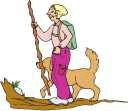 Hiking/backpacking
Hiking/backpacking
Most dogs in good shape can carry up to one-third their body weight in a special dog pack. Start with an empty pack stuffed with newspaper to acclimate your dog to the pack before adding weight on successive hikes. Don't let him drink from streams, which may contain parasites such as giardia. After the hike, check him for ticks, burrs, and dreaded foxtails.
Earthdog
In earthdog events, small terriers and dachshunds navigate an underground trench constructed especially for the event. At the end, they "confront" their prey – a tame rat protected in a cage. The dog can see the cage but cannot touch it, as it is safely placed behind strong vertical bars.
Don't worry about the rats. I've seen earthdog competitions and frankly, the rats seem totally bored by the proceedings. See AKC Earthdog events.
Obedience
Obedience is an activity in which your dog follows your commands to Heel, Sit, Down, Stand, Stay, Come, and in more advanced classes, Fetch, Jump, and hand signals. See AKC Obedience and AKC Rally and AKC Canine Good Citizen
But first... teach your dog basic obedience in the peace and quiet of your own home and yard. Start with my free online training programs.
Don't try to teach your dog new things in a public (group) obedience class. These classes can be hectic and stressful and dogs have a hard time learning when overwhelmed by distracting sights and sounds.
Safety is another major concern in public classes. The instructor may not know how to control a class full of owners and dogs. Meanwhile, all the beginners often can't control their own dogs, who may growl or lunge at your dog, negatively affecting his temperament.
Musical freestyle
Also known as Dancing With Dogs, you and your dog perform your own individualized choreographed routine that includes obedience exercises and tricks, all set to music. See Canine Musical Freestyle
 Tricks
Tricks
When your dog discovers that certain behaviors make you laugh and applaud and offer treats, he is happy to repeat those behaviors. Popular tricks include shake hands, speak, play dead, dance, spin, catch, and back up. Click the link to see how to teach them.
 Tracking
Tracking
In this activity, your dog uses his nose to follow a stranger's track to a glove or wallet dropped at the end of the track.
There's something magical about watching your dog put his nose to the ground and follow something invisible. Also you might keep in the back of your mind the dream that your dog will rescue someone and you'll be interviewed on the 6 o'clock news! See AKC Tracking
Scent Work
In this AKC event, a dog must search for cotton swabs saturated with an essential oil or with the scent of his owner. The dog uses his nose to find the hidden object, then alerts you by sitting, lying down, barking, or any other behavior that communicates the location of the target odor. See AKC Scent Work
 Lure coursing
Lure coursing
This high-speed, high-intensity activity has sighthounds (Greyhounds, Salukis, Whippets, and others) rocketing across an open field trying to grab an artificial lure pulled just ahead of them. Lure coursing allows these dogs to use their incredible speed and chasing instincts in a constructive way. See AKC Lure Coursing
 Herding
Herding
If your dog likes to round up the kids, put him to work on real livestock (sheep, cattle, goats, and ducks). Herding clubs provide the animals for your dog to practice with, and an instructor will show you how to control your dog around the livestock.
The most popular herding dogs in the US are Border Collies and Australian Shepherds, but other breeds with herding instincts can also participate. See AKC Herding
 Protection sports
Protection sports
Combining obedience and protection work, these challenging activities demonstrate a working dog's mental stability, physical endurance, structural soundness, courage, and trainability.
The most popular breeds in protection sports are German Shepherds, Belgian Malinois, Dutch Shepherds, Rottweilers, American Bulldogs, and Dobermans. See Protection Sports Association, Schutzhund/IPO/IGP, and Mondio Ring.
 Field/Hunting Tests
Field/Hunting Tests
If you own a hunting breed but have no desire to hunt, the two of you can still participate in casual field/hunting performance tests that measure your dog's instincts and abilities.
There are field tests for pointing breeds, for retrievers, and for spaniels. Even Beagles, Basset Hounds, and Dachshunds have their own field tests. Don't worry, no animal is ever harmed during these activities!
There are also basic field tests offered by national breed clubs. To see if there's one for your breed, do a search for breedname working certificate
 Jogging
Jogging
Jogging can be very risky for dogs.
When they run around on their own, THEY control the pace – sometimes faster, sometimes slower, pausing or stopping whenever THEY feel like it.
But running beside you, or running beside your bicycle, where they must maintain the pace YOU set, is not natural for dogs.
It's especially bad to do this on a hard surface (sidewalk or road), where each step creates a jarring shockwave that travels up your dog's leg and must be absorbed by his bones, tendons, and joints. Yes, lots of people do jog/bike with their dogs, but those dogs typically pay the price with joint problems later in life.
If you do decide to jog with an athletic dog:
- Wait until your pup's bones and joints are mature – at least 10 months in small breeds like terriers, at least 14 months in medium breeds like Border Collies, at least 18 months in large breeds like retrievers.
- Jog ONLY on a soft surface like a dirt track. Never jog a dog on pavement.
- Build up to a maximum of 4 or 5 miles.
- Jog only during cool weather.
- Stop regularly to give him a rest and a drink of water.
Exercise for active breeds
Many dogs described as hyperactive, over-exuberant, or destructive are dogs who aren't getting enough exercise.
A hyperactive, destructive dog is trying to vent bottled-up energy. You can't fix this kind of "misbehavior" with training. You must provide more exercise.
Most breeds were developed for working purposes. They were NOT intended to be simply pets.
Owners make a huge mistake when they get, for example, a Border Collie, Weimaraner, American Bulldog, or Siberian Husky, and think that the dog will be happy with minimal exercise.
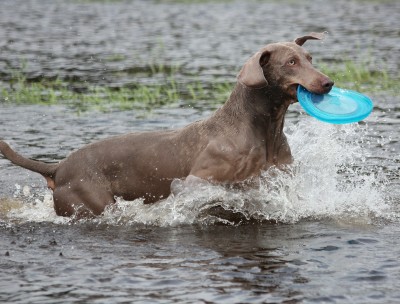
Weimaraners need a LOT of exercise and interesting activities to keep them feeling satisfied
A breed with a working background may bounce off the walls because you're walking him around the block a few times or assuming that he'll exercise himself if you just put him outside in the back yard.
For active dogs, choose vigorous activities from the Master List of Exercise Options earlier in this article.
Exercise for puppies and adolescents
Puppies and adolescent dogs should NOT be vigorously exercised. They shouldn't accompany you when you go jogging or cycling, and they shouldn't jump over anything higher than their own height at the shoulder.
When immature dogs are allowed to do too much, their growing bones, joints, and tender tissues can be seriously damaged.
You must wait until the "growth plates" in their legs have closed and their bones and joints are settled and mature: roughly 8-10 months in small breeds, 12-14 months in medium breeds, 14-18 months in large breeds, and 18-24 months in giant breeds.
Safe exercise for puppies and adolescents
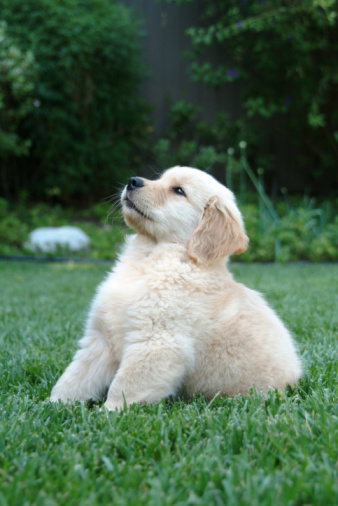
Young Golden Retrievers should NOT be exercised vigorously until their growth plates have closed at roughly 14-18 months
- interactive play sessions (with you) every day so they tone their muscles safely while learning controlled play (such as short, moderate-intensity games of Fetch or Tug)
- short walks (up to 20-30 minutes) so their joints aren't jarred for too long
- swimming, which provides wonderful exercise with no jarring of their tender bones or joints
- playing with a (well-known to you) dog who won't overpower the puppy or goad him into endless running games
- negotiating an obstacle course (low jumps, tunnels, a raised catwalk) that develops coordination and self-confidence
Exercise for old dogs
Though it may seem kind to let your old dog lie around and rest, it isn't. Exercise is very important for elderly dogs.
Exercise helps maintain a trim shape. Being overweight is especially dangerous for middle-aged and elderly dogs because it places extra stress on their weakening joints and heart. If the joints break down, painful arthritis will set in. If the heart breaks down, the lungs, liver, and kidneys will follow.
Obesity inevitably leads to a downward spiral in health. Slim dogs are healthier and live longer.
Exercise also helps maintain MENTAL health. Physical activity keeps oxygen and blood sugar at optimum levels in the brain. Without these nutrients, older dogs become dull and disinterested in the world.
Exercise allows you and your old dog to spend time together. It's important for his sense of well-being that he continue to feel special.
Safe exercise for older dogs
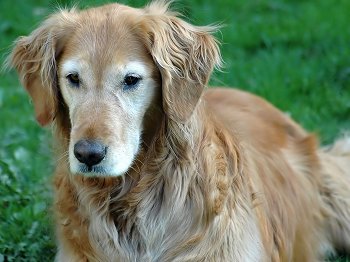
Senior Golden Retrievers should NOT be exercised vigorously, but DO need regular mild exercise to keep them healthy
- Swimming (ideally in warm water). Tones the muscles and strengthens the heart, with no wear and tear on his old joints.
- Limited fetch. Toss a loved ball or toy across a soft surface (such as grass or carpet). Do only a few throws per session.
- Walking. Limit walks to 10-20 minutes. Try to walk on soft surfaces and in pleasant weather. Cold or damp weather aggravates old joints.
- Supervised play with another (well-known to you) dog. Gentle, controlled play can be rejuvenating for an older dog. But make sure a younger, stronger dog doesn't goad your old fellow into vigorous running games.
Exercise for overweight dogs
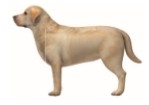 Chubby dogs are more likely to develop heart disease, lung disease, diabetes, and tendon, ligament, and joint injuries. So you need to get that extra weight off. That means less food (but also the right kind of food) and more exercise
Chubby dogs are more likely to develop heart disease, lung disease, diabetes, and tendon, ligament, and joint injuries. So you need to get that extra weight off. That means less food (but also the right kind of food) and more exercise
Safe exercise for overweight dogs
- Walking. Start with two 10-minute walks each day, gradually increasing time and distance.
- Playing with another (well-known to you) dog.
- Swimming. Keep sessions short and stay close to your chubby dog in case he gets tired and needs assistance. (Also consider a canine life preserver).
- Fetch. Toss the ball less than 30 feet and repeat only a few times per session.
Exercise for toy dogs
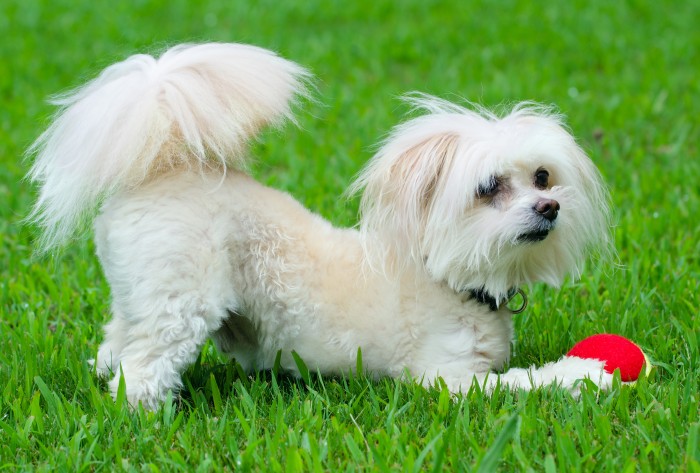
This little Maltipoo is raring to go!
Toy breeds are often billed as "Perfect apartment dogs because they never need to go outside."
This is wrong. And sad. Most toy dogs are little athletes who love to romp on grass, chase butterflies, and sniff out the latest doggy news around telephone poles... just like larger dogs.
Toy dogs who are confined to their house and yard tend to be unsocialized and can be the noisiest, nastiest, or most timid representatives of their breeds. So try to get your toy dog out into the world as much as possible.
But you do need to be careful.
A tiny creature can be seriously injured by something that a bigger dog would barely feel, such as being accidentally conked on the head by a thrown ball at the park.
 Keep toy dogs on-leash outside your yard. They are too quick to dash off, and virtually everything is a potential danger to them. I have personally witnessed the horrifying spectacle of a large dog suddenly appearing out of nowhere, grabbing, shaking, and killing a friend's toy dog.
Keep toy dogs on-leash outside your yard. They are too quick to dash off, and virtually everything is a potential danger to them. I have personally witnessed the horrifying spectacle of a large dog suddenly appearing out of nowhere, grabbing, shaking, and killing a friend's toy dog.
Owning a toy breed means constant supervision and surveillance of what's going on around your tiny dog. Too much can happen to these little guys in the blink of an eye.
Safe exercise for toy dogs
- Walking. For 15-30 minutes at a time, in pleasant weather. Most toy dogs don't like cold or damp.
- Free running. In a safe enclosed area.
- Fetch, with soft toys or or balls or squeaky toys.
- Playing with other small dogs. Toy dogs love to chase and wrestle with other toy dogs. Allowing them to play with a larger dog is very risky. Even if the larger dog means well, a friendly head butt, playful pawing, or a misplaced step can injure a toy dog.
- Negotiating an obstacle course of small jumps, tunnels, and raised catwalks.
Exercise for giant breeds
- Bone cancer is one of the leading killers of giant dogs.
- Joint diseases are a major health problem in giant dogs.
Therefore the bones and joints of giant breeds should be carefully protected, especially when they're still growing.
Giant breed puppies are much more fragile than they look. Slow growth and no forced exercise when young (up to 24 months old) can help prevent orthopedic diseases in giant breeds.
Now, that doesn't mean NO exercise.
Giant breeds who are under-exercised will end up with muscles, ligaments, and tendons that are too weak to support all the weight they need to carry as adults. That leaves them more vulnerable to injury.

Safe exercise for giant breeds up to 24 months old
- Free play with another (well-known to you) dog. Free play is the best exercise for young giant breeds because they tend to flop down and rest when they've had enough. Don't let young giants play with bossy dogs who try to goad the clumsy youngster into vigorous games that go on and on.
- Swimming. Tones your giant pup's muscles with no impact or concussion from the hard ground.
- Walking. Limit walks to 20 minutes, which minimizes the stress of repeatedly jarring their long gangly legs and immature joints. Once mature, longer walks are fine, but you should never jog or bicycle with these dogs.
Exercise for flat-faced breeds
Flat-faced breeds have inherited deformities in their face, nasal passages, and respiratory system.
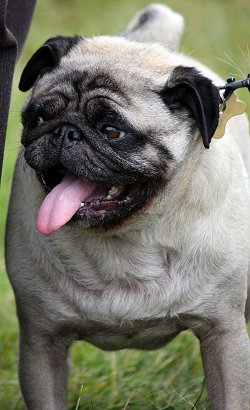
Poor Lil' Puggy
This makes it difficult for them to breathe easily, especially in hot humid weather. In the summer they should be kept indoors in air-conditioning and supervised during outside activity so they don't become overheated and suffer heatstroke.
To safely exercise these dogs, stick with moderate walks in cool weather, moderate games of fetch (if they're willing), and playing with a compatible (and well-known to you) dog who won't push the flat-faced dog to the point of dangerous panting and overheating.
When you own a breed with a deformity, you must keep him safe!
My best-selling books – now available FREE on my website
 Respect Training For Puppies: 30 seconds to a calm, polite, well-behaved puppy is for puppies 2 to 18 months old. Your puppy will learn the 21 skills that all family dogs need to know. Click here to read for free.
Respect Training For Puppies: 30 seconds to a calm, polite, well-behaved puppy is for puppies 2 to 18 months old. Your puppy will learn the 21 skills that all family dogs need to know. Click here to read for free. Teach Your Dog 100 English Words is a unique Vocabulary and Respect Training Program that will teach your adult dog to listen to you and do what you say. Click here to read for free.
Teach Your Dog 100 English Words is a unique Vocabulary and Respect Training Program that will teach your adult dog to listen to you and do what you say. Click here to read for free. 11 Things You Must Do Right To Keep Your Dog Healthy and Happy helps your dog live a longer, healthier life. Get my honest advice about all 11 Things before you bring home your new puppy, because some mistakes with early health care cannot be undone. Click here to read for free.
11 Things You Must Do Right To Keep Your Dog Healthy and Happy helps your dog live a longer, healthier life. Get my honest advice about all 11 Things before you bring home your new puppy, because some mistakes with early health care cannot be undone. Click here to read for free.
